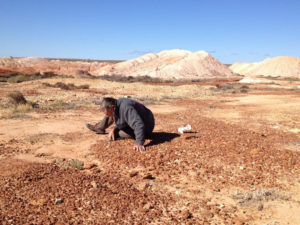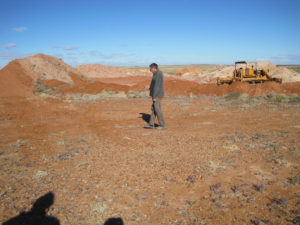Noodling and Specking for Opal
Opal mining in Australia is in decline compared to the earlier days. Most of us cannot afford to spend the large amounts of money required to mine for opal and would not have the expertise anyway, But noodling and specking for opal at Andamooka is well within our reach.
The early miners often left behind pieces of opal they discarded or just didn't see. The very early miners were working in tunnels using a candle for light and could quite easily miss an opal which was buried in the clay. This would be carted up to the surface and dumped on the mullock heaps. These miners were looking for good quality opal, and as there was no market for the seconds, they were not too careful with these lower grades and some of the mullock heaps have been good locations to noodle and speck for opal.
I prefer to only noodle up to a depth of of about 300 mm on the outer surface of the mullock heaps. The lower down material would have come from the excavation of the shaft which was not opal bearing material, so why look through that. Some one told me the best place to try was on the side of the mullock heap closest to the shaft but that seems too dangerous to me as I don't want to fall down a deep shaft.

Mullock heaps at Andamooka
Later, miners moved in with tunnelling machines instead of picks and shovels. These machines were lowered down large shafts and set up near the opal level where their rotary blades would slowly dig a circular tunnel. The miner operating the machine would be looking carefully at the face and also listening for the tinkling sound of the blades striking an opal. I have never done this but I can imagine it would be easy to miss some opal. Any missed pieces would then fall down and mix with the clay and sandstone that was being cut. It was then either carted out or sucked out of the shaft by large suction machines and dumped either in trucks or on the mullock heap adjacent to the shaft.
More recently, large bulldozers and excavators have been brought in to open cut the old mined areas, These machines have pushed the overburden up into large heaps. The miners would follow up behind the dozers when they were close to the opal level and look for any sign of opal that had been disturbed. They could easily miss some as it would be covered in clay.

The author Specking virgin ground
At Andamooka, a large amount of this excavated material has been carted and stockpiled in enormous heaps just out of town and there is no doubt there is a bit of lovely opal mixed with all this dirt.
Noodling at Andamooka
What I mean by noodling is sitting on a heap of mullock and carefully sifting through the surface material looking for discarded pieces of opal. The easiest way is to sit on an old cushion as the opal dirt is very lumpy and uncomfortable, and, using a small hand shovel, scrape away a thin layer of the dirt. If you are careful and there is any opal there you will see it.
Make sure you are not on a registered claim when noodling and specking. Claims are marked by posts at each corner of the claim. Miners definitely do not like people entering their claims without permission.
What you can find at Andamooka
Andamooka is one of the most exciting places to noodle for opal, as there is more than one type of opal to be found here
Gem Opal rough looks like a piece of glass. You won't miss it. Matrix opal is also found found at Andamooka. It is a bit harder to spot as it often looks like a hard bit of white clay. If you look at it carefully you will see tiny flecks of pale colour. It is worth keeping if you find any as it can be treated with sugar and acid to darken the background and reveal the colours much more clearly. A third type of material found in the heaps is "concrete" or Rainbow Matrix. This looks like a grey piece of concrete but on close inspection reveals specks of coloured opal in it. It also can be treated and if coated with liquid glass can result in a beautiful gem. And there is more. You will often see oblong worn grey stones on the surface or buried in the mullock. Most are worthless but check them to see if they have a crack in them filled with a thin vein of opal. If you find one give it a hit with a hammer and try to split it along the crack to expose the surface of the opal. What you will have then is a "Painted Lady" and these can be worth quite a bit. (several hundreds of dollars if it is colourful opal). In addition to all of these there are old mining relics such as coins, buttons etc.
You need Patience
The main thing you have to have when noodling is patience. The size of the heaps can be enormous covering many acres and it is always extremely discouraging to look at them and wonder where to start. It is too easy to walk away and give up, but, if you want to find an opal you just have to give it a try. Even the mullock heaps themselves are a bit disconcerting if you think too much about it. There were many shafts sunk at Andamooka and only a few miners ever found opal. Logically, therefore,you would need to be lucky to pick out the mullock heap of a successful miner knowing that most of them found nothing and therefore there would be no opal in the heaps. In the 1970's and 1980's it was possible to speck the heaps and often pick up a small piece of opal on the surface. Specking is walking along slowly staring at the ground looking for opal. Once you found a small piece on a mullock heap you could assume there may be more and you would select that heap to noodle. Unfortunately many people have specked the heaps since then and it it is difficult to find anything on the surface.
So, it is back to luck. Just select any heap and try your luck. It is quite relaxing scraping away the surface as long as you are comfortable. An old cushion to sit on and a good hat will help as it can get a bit hot out in the sun.
Another method of noodling
Some people like to sieve the material in the mullock heaps. You will need a reasonably coarse sieve, a shovel and some water. I have seen people using an old ironing board to rest the sieve on so you can check out the contents of the sieve while standing up. This is much more comfortable than sitting or squatting.. The idea is to shovel a small amount of mullock surface material into the sieve and sieve out the really fine particles. Then pour a bit of water over the remaining material and look for any signs of colour . The use of water helps greatly as it washes away fine dust and helps to reveal any opal.
Make sure you stand with your back to the wind while sieving or else you will end up covered in fine white powdery dust.
I have seen this method used very successfully at Yowah. The person noodling was there for three weeks and found some lovely pieces of opal but he also went days not finding a thing. He had patience and perseverance and it paid off.
Where else to look for opal
I have discussed the mullock heaps and mullock dumps as sources for specking and noodling. There are other places also. At Andamooka the are many dirt roads. The surface material for these roads has all come from old mullock heaps. Someone has scooped this material up and spread it out on the road surface to fill in potholes etc. So here is another spot to look for opal. I have found some lovely matrix opal in the middle of a road and I am sure there is plenty more if you look carefully. But do look out for traffic.
After a heavy fall of rain have a wander along any old creek or scoured surfaces. The water flow can uncover pieces of opal that have been buried. I found a nice piece of crystal opal in the creek bank at Andamooka and have heard stories of others finding opal also. A word of warning though. Do wait until the surface has dried after the rain. If you don't you will end up about 150mm taller as the surface clay sticks to your boots and makes walking very difficult.
Opal Divining
I only mention this in passing as I don't really believe in it, but some people do. I have heard people swear that they can divine opal using divining rods. None of these people were rich so I do have some doubts. I was once convinced to have a try and not be so sceptical. The owner of Far King Excavations at Andamooka had just finished showing me over his open cut at White Dam when he suggested I try divining. See next photograph.

Divining for opal at White Dam
Perhaps I had no luck because I was using only one divining rod. Anyway I did not find any and he had not found much in his extremely deep excavation. You can buy water divining rods and I have been told they should work for opal. Best of luck if you try them.
If you love opal and really want find one for yourself then do spend a week or so at Andamooka. There are plenty of places to try your luck and even if you don't find any opal there is such a lot to see. Best of luck with the noodling and specking.
Johno